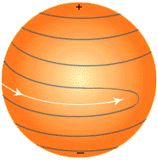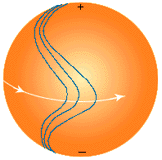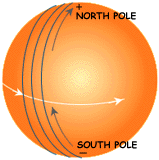| |
As the Sun rotates,
the Convection Zone spins faster at the equator than it does at the poles. Beneath the Convection Zone, the Radiation Zone spins as a sold mass. The different ways that these two zones move causes the Sun's magnetic field to stretch at the equator.
| | |
| As the solar cycle continues,
these lines of magnetic force continue to stretch.
Like a rubberband that's twisted too much, the magnetic field begin to buckle.
Eventually, the magnetic force, which is generated beneath the Convection Zone, breaks the surface of the Sun. |
 |
| 
|
| |
When this happens, all sorts of strange activity occurs: - Sun spots form
- the Corona heats up
- solar flares and loops erupt from the Sun's surface
These phenomena are like giant magnetic storms that not
only alter the Sun's surface, but also eject powerful bursts of energy out into the Solar System.
The peak of all this activity is called the "Solar Maximum." At these times, we on Earth
can experience magnetic disturbances like disruptions in satellite communications and
atmospheric events like the Aurora Borealis. Following the Solar Maximum, the magnetic field begins to unwind and activity
on the Sun subsides. Gradually, the Sun returns to the Solar Minimum and the cycle begins again.
The Sun reached a Solar Minimum around 2006. The next Solar Maximum should occur around 2012 to 2015. |
|



